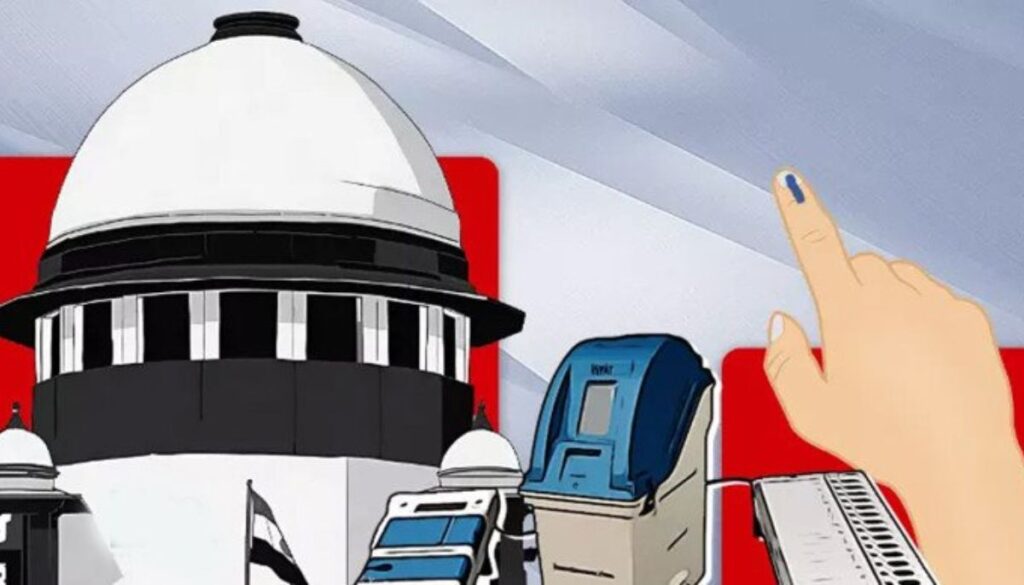The recent Supreme Court hearing on Electronic Voting Machines (EVMs) and Voter-Verified Paper Audit Trail (VVPAT) has sparked renewed discussions about election security and verification processes in India.

Election Commission answers questions regarding the microcontroller and storage duration of the EVM; Supreme Court holds judgement on the cross-verification motion.
What the Supreme Court remarked during the hearing on the EVM-VVPAT case: “We cannot control elections.”
Following a senior Election Commission official’s response to the court’s questions, the Supreme Court on Wednesday reserved its decision on a series of applications seeking full cross-verification of votes cast using EVMs with Voter Verifiable Paper Audit Trail (VVPAT). The questions focused on the capabilities of the micro-controller that is built into the EVMs, how to secure the EVMs and VVPATs, and how long the machines can be kept in service.
The court noted throughout the hearing that elections are outside its jurisdiction and should be handled by another constitutional body.
A bench consisting of Justices Sanjiv Khanna and Dipankar Datta stated that further clarification is required on a few points due to some ambiguity in the EC’s responses to its “frequently asked questions” (FAQs) about EVMs.
“We went through the FAQs. We just wanted three-four clarifications. We don’t want to be factually wrong but doubly sure in our findings and hence we thought of seeking the clarification,” the bench told Additional Solicitor General Aishwarya Bhati who was appearing for the EC.
“First clarification needed is with regard to microcontroller. Whether it is installed in controlling unit or in the VVPAT. We were under the impression that the microcontroller is the memory installed in the control unit (CU). One of the questions in the FAQs indicates that it is also installed in the VVPAT,” the bench said.
Senior Deputy Election Commissioner Nitesh Kumar Vyas clarified that all the three units have their own microcontrollers that cannot be accessed physically.
“The one-time program is burnt into them,” Vyas told the court, adding that they cannot be changed.
The court also requested information regarding the 45-day storage of EVMs. The bench stated that it was informed that the EVMs are kept for 45 days because there is a 30-day window for filing an election petition.
Also Read | WHAT CHINA RESPONSE TO MOHAMED MUIZZU’S PARTY AFTER VICTORY IN MALDIVES ELECTION
“We discovered that the EVM filing deadline is 45 days after consulting Section 81 of the Representation of People Act. As a result, kindly confirm with us that the storage is for 30 or 45 days. The court noted that if the 45-day limitation period is observed, the appropriate storage time must be extended.
The EC official informed the court that all the machines are stored for 45 days.
“On the 46th day, CEO writes to Registrars of concerned high courts to ascertain if any election petition filed. If any Election Petition is filed, the machines remain stored,” the official said.
Senior advocate Santosh Paul, appearing for one of the petitioners, said that source code of EVMs should also be disclosed for transparency.
The bench said, “No, the source code cannot be disclosed as there is a chance of it to be misused.”
FAQs:
1. What is the debate surrounding EVMs and VVPATs?
The debate centers on the possibility of manipulation and the need for greater transparency in the voting process. Some argue that EVMs are vulnerable to tampering, while others believe VVPATs offer a sufficient verification measure.
2. What was the Supreme Court’s stance on scrutiny?
The Supreme Court emphasized the importance of verification through VVPATs. However, they cautioned against excessive scrutiny based on mere suspicion and acknowledged the Election Commission’s role as the primary authority on conducting elections.
3. Can courts control elections?
The Supreme Court asserted that it cannot directly control the election process.expand_more They operate within the legal framework and rely on the Election Commission’s expertise to ensure free and fair elections.exclamation
4. What are the next steps after the hearing?
The Supreme Court’s full judgment on the matter is awaited. The focus will likely shift towards implementing robust verification procedures and ensuring public confidence in the EVM-VVPAT system.
5. What can voters do to ensure a secure and fair election?
Voters can familiarize themselves with the voting process, verify their VVPAT slips during casting their votes, and report any irregularities to the concerned authorities.











Source code mein hi saara khel chupa hai jo yeh DALAAL #ECI commissioner says cn be misused 😆😂
Yes it can be MUS USED 😝😅
OHHH SORRY it’s being MISUSED NOW by modi to win LokSabha elections cos jab tak evms hai modi hai,EVMS khatam, panauti modi khataam 😆😂